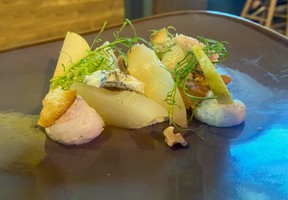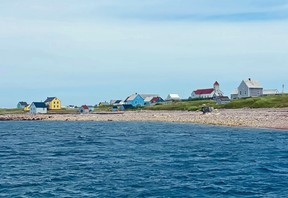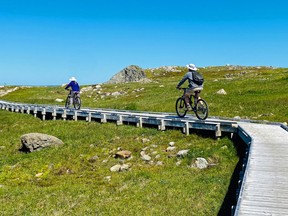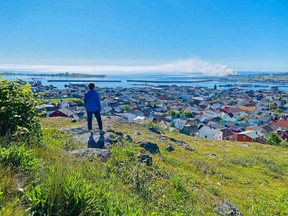Reviews and recommendations are unbiased and products are independently selected. Postmedia may earn an affiliate commission from purchases made through links on this page.
Article content
If you want to sound like a local in Saint-Pierre, greet someone by saying, “Sadit.” The word is unique to that part of the world and it means, “How’s it going?” You’ll know you did it right if the person responds with, “Ca péte,” which technically means “it farts”- a far more interesting response than the typical North American “fine.”

Saint-Pierre and Miquelon is a place unlike any other – a tiny piece of France just off the eastern shore of Newfoundland with a fascinating history and interesting culture. The 242-square-kilometre archipelago consists of eight islands collectively known as Saint-Pierre and Miquelon. The people who live there are citizens of France and even though you can reach the islands by ferry, the euro is the currency and you’ll need an adapter for the electrical sockets.
Advertisement 2
Article content
When you take the short ferry ride back to Newfoundland, you must clear Canadian customs and abide by the regulations for bringing goods into Canada – something that can be a challenge if you’re a lover of French wine and want to bring back more than two bottles.
Located just 25 kilometres off the Burin Peninsula of Newfoundland, it isn’t surprising that the landscape and climate of Saint-Pierre and Miquelon bear a resemblance to the nearby province. It is rocky and rugged and, like Newfoundland, fishing has long been a traditional occupation. From a hillside overlooking the community of Saint-Pierre or from hiking trails along the island, you could almost believe you’re still in Newfoundland. But when you look harder, you notice the little things – French licence plates on vehicles, friendly locals who greet each other with kisses on both cheeks, fantastic French pastry shops and French wines and cheeses in the restaurants and grocery stores.

What truly sets this place apart is its fascinating culture. It’s been said that food is the ultimate embodiment of culture and I began my exploration of the culture with dinner at l’Essential, a French coffee bar and café that also sells a variety of handmade artisan products. Through a translator, chef and owner Nathalie Goupilliere explained that this restaurant and the food she makes with local ingredients is her way of sharing the culture of Saint-Pierre. The food is fantastic in Saint-Pierre and I dined at several wonderful restaurants over three days.
Article content
Advertisement 3
Article content
Diving into the quirky history of these islands is another way to understand the local culture. I visited the Heritage Museum and joined a Prohibition Tour led by local guide Eric Simon. Historically, fishermen on these islands barely scraped by – taking on debt to fund their operations and not getting any pay for their efforts until the fish reached European markets.
Prohibition in the United States and Canada was a boon for Saint-Pierre and Miquelon, which never had prohibition laws. The islands became a haven for gangsters like Al Capone and rum runners who smuggled alcohol into the United States and Canada. Millions of litres of whisky, wine, Champagne and spirits flowed through the islands and locals made money storing it in the basements of their houses. “For many locals, it was the first time they could earn money without backbreaking labour,” Simon explained. “Sometimes crime pays. The Catholic school was built with funds from Prohibition alcohol sales. The trade made the islands quite rich for a time.”

Île-aux-Marins which means “Island of the Sailors” is another fascinating historical day tour on the islands. Originally settled in 1604, the island just off the shore of Saint-Pierre was home to a cod fishing settlement of almost 700 people. As cod fishing died off, so did the community. The last of its residents left in 1963 leaving the abandoned buildings behind to eventually become a special kind of museum showcasing the life of a typical maritime cod-fishing community. I spent an afternoon wandering around the island – stepping inside several buildings including the schoolhouse and Notre Dame des Marins, the beautiful wooden church.
Advertisement 4
Article content
Three days was not enough time to explore everything there is to see in Saint-Pierre and Miquelon, but it was enough to get a small taste of a little piece of France that represents the last vestige of the once vast territory of New France. How did my visit go? You could say it farted.

How did a French territory end up off the coast of Newfoundland?
It’s complicated. Saint-Pierre and Miquelon was originally part of New France, a vast French colony in North America. After years of conflict, France lost the Seven Years’ War and ceded the territory of New France to Britain in the 1763 Treaty of Paris. An earlier 1713 treaty conferred fishing rights to France in the area surrounding Saint-Pierre and Miquelon and France convinced Britain to give back the archipelago. Britain took over the archipelago a few more times, but in 1816 it became a permanent part of France.
If You Go:
Where to Stay: I stayed at Auberge Quatre Temps, a cozy bed and breakfast with eight rooms and a great restaurant.
Where to Eat: l’Essential, Auberge Quatre Temps, L’Îlot restaurant, Le Select, and Le Bar à Quai.
Where the Locals Go: Le Rustique bar
Saint-Pierre and Miquelon Tourism website: en.spm-tourisme.fr
Debbie Olsen is an award-winning Métis writer and a national bestselling author. Follow her adventures at www.wanderwoman.ca.
Article content

